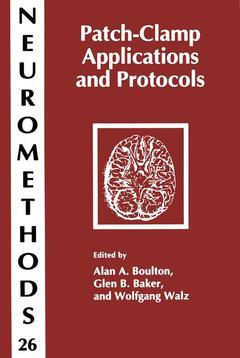Description
Patch-Clamp Applications and Protocols, Softcover reprint of the original 1st ed. 1995
Neuromethods Series, Vol. 26
Language: English
Subject for Patch-Clamp Applications and Protocols:
316 p.
· 15.2x22.9 cm
· Paperback
Description
/li>Contents
/li>
E. Neher and B. Sakman were the first to monitor the opening and closing of single ion channels and membranes by conductance measurements. In 1976, they used firepolished micropipets with a tip diameter of 3-5 pm to record currents from a small patch of the membranbe of sk- etal muscles, thereby decreasing background membrane noise. In order to reduce the dominant source of background noise-the leakage shunt under the pipet rim between m- the muscle membrane had to be treated brane and gla- enzymatically. Despite these early limitations, a new te- nique was born -the patch-clamp technique. The final bre- through came in 1981 when the same authors, in collaboration with 0. P. Hamill, A. Marty, and F. J. Sigworth, developed the gigaohm seal. Not only did this improve the quality of recordings, it was now possible to gently pull the membrane patch with the attached pipet off the cell and study its trapped ion channels in isolation. Another offshoot of the gigaohm seal technique was the whole-cell patch-clamp technique, in which the patch is ruptured without breaking the seal. This technique is really a sophisticated voltage-clamp technique and also allows for the altering of cytoplasmic constituents if the experimenter so wishes. The first part of Patch-Clamp Applications and Protocols presents modern developments associated with the techn- ogy of patch-clamp electrodes, of cell-free ion channel reco- ing, and of the whole-cell patch-clamp technique.
Technology of Patch- Clamp Electrodes.- Whole-Cell Patch-Clamp Recordings.- Pressure/Patch-Clamp Methods.- Cell-Free Ion-Channel Recording.- Perfusion of Patch Pipets.- Concentration Clamp Technique.- Perforated Patch-Clamp Technique.- The Loose Patch Voltage Clamp Technique.- Patch-Clamp Recording and RT-PCR on Single Cells.- Patch-Clamp Technique in Brain Slices.- Xenopus Oocyte Microinjection and Ion-Channel Expression.
© 2024 LAVOISIER S.A.S.
These books may interest you

Ion ChannelsVolume 1 52.74 €

Patch-Clamp Methods and Protocols 126.59 €

Patch-Clamp Methods and Protocols 179.34 €

